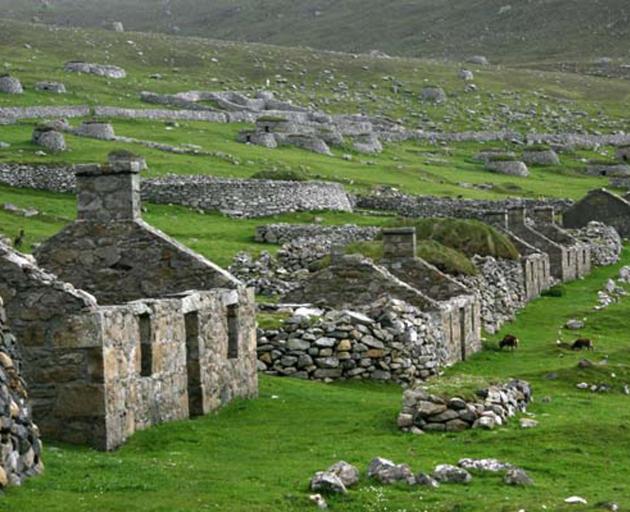

One house beckoned to me. Its slate informed me that this sad little swelling was the former home of Lady Grange, the wife of a Jacobite sympathiser. Lady Grange had been exiled to this island when her husband became fearful that she might spill his secrets. The poor woman felt perpetually out of sorts here on St Kilda, which she described as a "wile neasty, stinking poor isle". Boswell and Johnson discussed the matter of Lady Grange during their 1773 tour of the Hebrides. Johnson believed that if "M’Leod would let it be known that he had such a place for naughty ladies, he might make it a very profitable island". I had a sudden vision of a wild band of shady ladies-cum-harlots scampering all over the island among the bewildered sheep.
On a hill, through large sheepfolds, were the curious little "cleaiteans" that decorated the hillside. These dome-shaped structures are constructed of flat boulders with a cap of turf on the top, and were used for storing peat, grains, nets, preserved meat and hay. I crawled into one, and peered through a chink in the wall at all the other tourists, striding around the island with their cameras and lunch boxes. Bile rose in my stomach when I realised this particular cleaitean was also inhabited by the decaying, bloated corpse of a long-dead sheep.
"Where is the land which has neither arms, money, care, physic, politics, nor taxes? That land is St Kilda." So wrote Lachlan McLean, a missionary from the island of Tyree in 1838. Virtually ignored by the mainlanders (who were too busy fighting petty battles and squabbling over crowns), the St Kildans were left to develop their own form of society. A form of communism emerged wherein decisions affecting the whole community were made in a collective manner.
Work was assigned on the basis of individual skill, and there was no such concept as "private property" — excepting the beds and cottages one slept in. Every morning, a daily "parliament" met in the street after prayers. Here, all the adult males decided on the day’s activities. According to one islander, "discussion frequently spread discord, but never in recorded history were feuds so bitter as to bring about a permanent division in the community". If only the same could be said about Westminster or the Beehive.
Even into the late 19th century, the islanders communicated with the world by lighting a bonfire on the summit of Conachair and hoping a passing ship might see it, or by using the "St Kilda mailboat". This was the invention of John Sands, a visitor to the island in the 1880s. During Sands’ stay, a ship called Peti Dubrovacki ran aground in Village Bay. The captain and eight of the crew were saved, virtually seconds before the boat was dashed to pieces on the rocks. Romance bloomed between one of the Austrian sailors and a St Kildan lass, although neither understood the language of the other.
After about five weeks, supplies were running perilously low. Sands retrieved a lifebuoy from the hapless Peti Dubrovacki and attached a message to it, before flinging it back into the ocean. Nine days later, it washed up in Birsay, Orkney, and a rescue was arranged, much to the chagrin of the two lovers, who tearfully bade farewell to each other with many sighs and kisses. Hereafter, the St Kildans would fashion a piece of wood into the shape of a boat, attach it to a sheepskin bladder, and place in it a small bottle or tin containing a message. These little boats were launched when the wind came from the northwest, and for the most part successfully found their way to the west coast of Scotland — or, less conveniently, Norway.
Gone are the days of these little bladder-boats, bobbing happily from St Kilda to the mainland. As the 19th century drew to a close, there was a gradual increase in the type and frequency of contact with the world at large. Eventually, the continual gawking of tourists and passing cruise ships, coupled with tales of the easy mainland lifestyle, began to wear down the islanders. A plan for the evacuation was devised remarkably quickly.
Sheep belonging to the islanders were sold, and the proceeds used to offset the costs of transporting the people and their belongings.
On August 29, 1930, as the first blush of dawn bloomed on the horizon, the islanders readied themselves for departure. The calm and sparkling sea lay beckoning, as the sun warmed the impassive cliffs of Oiseval. St Kilda must have seemed paradise to the islanders as they farewelled their home, heading out into the great unknown, the mainland of hunger and haste. Ever respectful of tradition, the islanders left an open Bible and a small pile of oats in each house, before locking the doors and boarding the Harebell. Surely there were tears as the island faded into the horizon. The umbilical cord between man and island stretched and finally snapped as the faint outline of St Kilda dissolved into the sunshine.
Eighty-five years later, it was my turn to depart. I left feeling that my presence on St Kilda had deprived the place of some of its mystery. Even as the mainland came into sight, I stayed on the deck, clinging to the rails. A rainbow broke through the mist. St Kilda would always remain a bastion of the old way of living; a safe haven for sheep, gannets and the odd solitary soul.
- Jean Balchin, a former English student at the University of Otago, is studying at Oxford University after being awarded a Rhodes Scholarship.











